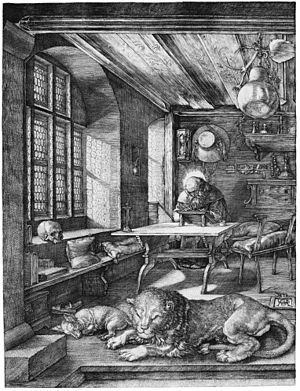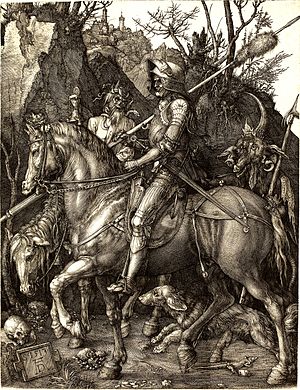
Albrecht Dürer was a German painter, engraver, printmaker, and mathematician in the late 1400s and early 1500s. Dürer was only in his twenties when he became a great influence across Europe during the Northern Renaissance, mostly through establishing printmaking as its own independent art form. His legacy inspired other major artists such as Raphael to pursue printmaking, as it helped to distribute his work all across Europe during a time when paintings could only be held by few private collectors.
Dürer's printmaking involved woodcut, where he would draw a design on a plank of wood and a woodcutter would carve away parts that didn't need ink. Paper would be pressed over the block surface covered in ink to transfer the desired image onto it.
Dürer was regarded as the "greatest artist" of the Northern Renaissance, the Renaissance that occured in Europe north of Italy after the Italian Renaissance (the earliest in Europe). A talented, ambitious, and intelligent artist, Albrecht Dürer received attention from and became friends with the German elite - he was even the official court artist for Holy Roman Emperors Maximilian I and Charles V! When he wasn't busy drawing or painting for royalty, he enjoyed keeping company with the age's finest theorists and philosophers, along with researching human proportions (wrote several books on them).

Dürer's first self-portrait came at the age of 13 in 1484 using a silverpoint technique. Silverpoint is a traditional drawing technique used on manuscripts, made by using a silver rod or wire as a drawing tool. Dürer's father was a craftsman who taught Albrecht how to draw using metalpoint, hence how he created this masterpiece at a very young 13 years old. The lines in the portrait appear very fine and detailed like it could have been sketched using modern fine tip graphite. This effectiveness of silverpoint was a major reason why artists in the early Renaissance era favored this technique for fine line drawings.

At the age of 22, Dürer created his first painted Self-Portrait (1493) using oil on vellum paper. He frequently liked to cast a "bold light" on himself, "eager to assert his creative genius and inherent nobility, while still marked by a clear-eyed, often foreboding outlook." I find it interesting he is almost in the same position as his 13 year old self-portrait.

At age 26, he created yet another portrait of himself, in the same position. It is interesting to see the progression of Dürer's aging.
Three of Dürer's most famous metal engravings are shown below: Saint Jerome in His Study (1514), Melencolia I (1514), and Knight, Death and the Devil (1513). All were quite large engravings and were viewed as representing the three spheres of activity in the medieval times.

Theological and contemplative life

Intellectual life

Moral and "active" life
At first, I simply picked up a book called "Dürer, Rembrandt, and Goya" in Lilly Library thinking I would research Goya, however, flipping through Dürer's work intrigued me. The book was written in German, however, so it required me to look on the Internet for Dürer's biography. I never realized he was such an important figure, but learning about his life and amazing talent had me pleasantly surprised for choosing to research him. His pieces are so detailed and amazing for having been done through engravings and woodwork - something I imagine could have taken excruciating efforts to accomplish. It is humbling to read about such influential people and I'm glad I got the chance to see amazing work I would have probably never seen or heard about if not for a fancy volume that happened to catch my eye on the shelf.
Sources:
Dürer, Albrecht, 1471-1528; Goya, Francisco, 1746-1828; Rembrandt Harmenszoon van Rijn, 1606-1669; Rochard, Patricia; Internationale Tage Ingelheim. Dürer, Rembrandt, Goya: drei Giganten der grafischen Künste. Ingelheim: Boehringer Ingelheim. 2012. Print.
(Fun fact: The next closest copy of this book is in the National Gallery of Art Library in Maryland)
http://www.albrecht-durer.org/biography.html
http://www.metmuseum.org/toah/hd/durr/hd_durr.htm
http://www.ibiblio.org/wm/paint/auth/durer/
No comments:
Post a Comment